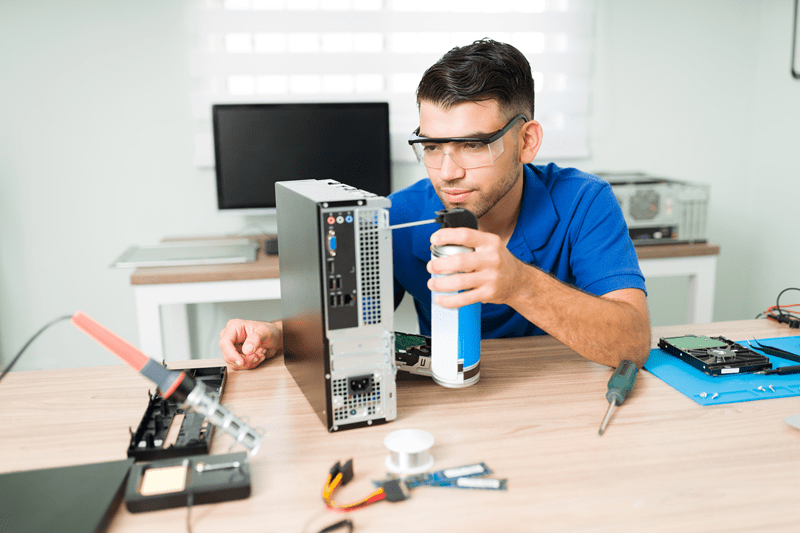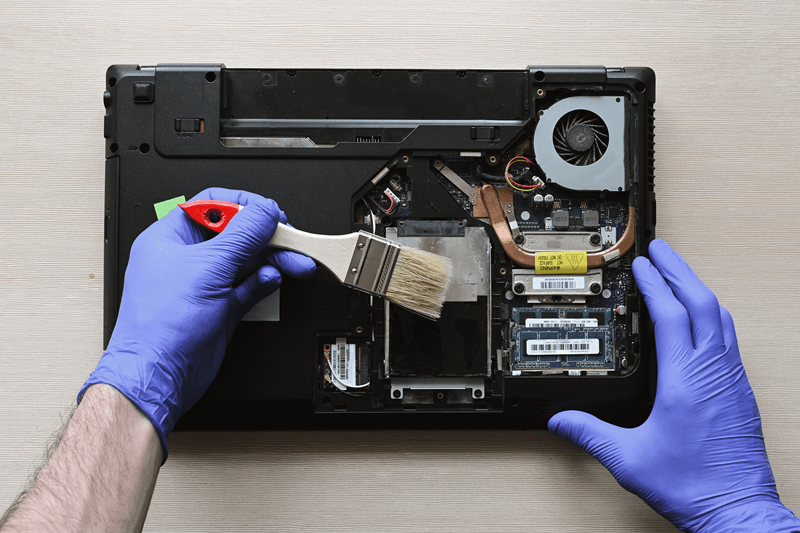All About Cleaning PC Hardware to Keep the System Dust-Free

This includes routine cleaning of your PC hardware, not just updating software and running antivirus scans. Of the major causes, there are overheating and poor performance caused by buildups of dust. Over time, dirt and grime can clog the fans and reduce airflow or even cause some component failure. Many users in the U.S. who game, work, and create on PCs should take heed of the importance of cleaning PC hardware.
It covers everything from dust removal and fan cleaning to static safety, creating a routine for maintenance, and ways to improve overall hardware care.
Why Cleaning PC Hardware Matters
Accumulation of dust traps heat and reduces airflow, putting extra load on the fans, hence reducing the cooling efficiency.
- Overheating reduces the life span of major components, which include the CPU, GPU, and power supply.
- Cleaning hardware at regular intervals prevents any sudden shutdowns, thermal throttling, and/or lagging of computers during resource-intensive tasks.
- Fans that are clogged with dust spin faster and also become noisier; a clean fan runs quietly and efficiently.
Cleaning PCs regularly means spending less money in the long run for replacements or repairs.
Understanding the Basics of Cleaning PC Dust
Therefore, dust removal does not involve just the act of wiping up but includes careful steps with proper equipment so that the work is done safely and effectively.
Tools Needed
- Compressed air can be used for reaching tight spaces and blowing out dust.
- Soft or anti-static brush for loosening the particles on the circuit boards.
- A microfiber cloth for wiping smooth surfaces without scratching.
- When air cleaning is complete, only a safe-for-electronic vacuum cleaner should be used to pick up loose dust.
- Anti-static wrist strap for static safety when working with components.
Dust Removal Steps
- First, turn the computer off, then unplug it from the wall outlet.
- Carefully remove the side panel, making sure the workspace is static-free.
- Before touching any parts, put on an anti-static strap or touch a grounded metal object.
- Use compressed air to blow off the dust, starting from the top, working your way down.
- Hold the fan firmly to prevent damage to bearings or motors when cleaning.
- Gently sweep away stubborn dust from heatsinks or circuit boards with a soft brush.
- Wipe down all visible surfaces using a microfiber cloth and then reassemble when completely dry.
These steps help in the attainment of total dust removal, keeping the components safe from static or incidental damage.
Fan Cleaning for Efficiency in Cooling
Fans are both the most important and most overlooked parts when cleaning PC hardware: dust-filled blades inhibit airflow, raise internal temperatures, and increase overall noise levels.
Main Types of Fans to Clean
- Case fans that push air through the system.
- CPU cooler fans that dissipate processor heat.
- Cooling fans on the GPU, or graphics card.
Steps to Clean Fans
- Switch off the power to the PC.
- Open the casing and locate all the fans inside.
- Compressed air should not be used to spin the fan blades.
- Instead, it's better to use short bursts of air instead of long ones to avoid any moisture buildup.
- Gently sweep away stubborn particles with a soft anti-static brush.
- Remove fans if necessary for deeper cleaning with isopropyl alcohol and a lint-free cloth.
- Allow the fans to dry completely before reconnecting power.
Cleaning the fans ensures better airflow and reduces system noise, hence providing an efficient overall cooling system for better hardware care.

Static Safety during Hardware Cleaning
The most serious risk when cleaning PC hardware is the static electricity that can easily damage sensitive parts. For this reason, it is very important to practice static safety.
Static Safety - Best Tips to Keep
- Work on a hard, flat surface rather than carpets and rugs.
- Wear an anti-static wrist strap that is connected to a grounded surface.
- Avoid synthetic or wool fabrics that can generate static charge.
- Periodically touch grounded metal objects to discharge your static.
- Store removed components in anti-static bags.
These precautions will let you safely remove the dust and clean the fan, without damaging the system's electronics in the process.
Creating a Maintenance Schedule
Since dust always accumulates-even in the cleanest environments regular maintenance cleans the PC of dust to keep it efficient.
Recommended schedule:
- Every 3 months: Have dust accumulations promptly removed from vents, exterior fans, and filters.
- Every 6 months: Do deeper cleanings of the fans and perform internal wipe-downs.
Perform full hardware maintenance once a year, including thermal paste checks and cleaning of cables.
Extra Maintenance Tips
- Install dust filters on intake fans and clean them monthly.
- Keep the computer slightly above the floor to reduce dust intake.
- Leave space around the PC for good air circulation.
- Avoid smoking, incense, or aerosol sprays around your setup.
- Keep your cables organized to make cleaning at later stages much easier.
A maintenance routine will prevent major buildup and ensure that your PC runs smoothly throughout the year.
Additional Hardware Care Tips
Cleaning components is not just dust removal; it also concerns the whole care for hardware to perform well and be reliable.
Other suggestions for hardware care include:
- Cable management is important for smooth airflow and to avoid hotspots.
- Thermal paste on the CPU should be replaced every few years for optimum cooling.
- After cleaning, utilize temperature-monitoring software such as HWMonitor or Speccy.
- Check all the fans for unusual noise that indicates worn bearings.
- Gently clean the vents of the power supply unit without opening the case of the PSU.
- Store unused parts in anti-static bags.
These steps improve hardware care and therefore increase the overall life of your system.
Common Cleaning Mistakes to Avoid
Even with the best of intentions, many users commit the following mistakes in cleaning the hardware of their PCs, which may lead to damage. Here are some mistakes to avoid for safe and effective results.
Mistakes to avoid:
- Avoid water or household cleaning sprays, as those can corrode the electronics.
- Overspinning fans with compressed air can break the bearings.
- Poor static precaution, like first grounding yourself.
- Using regular vacuum cleaners that generate static discharge.
- Clean the system while it's powered on.
Knowing these common mistakes to avoid will ensure that cleaning and dusting fans are both safe and effective.
Long-Term Benefits of Regular Cleaning
The rewards of constant cleaning of hardware on a PC are many. A well-maintained computer will undoubtedly perform better, last longer, and even work more silently. Benefits include the following: Less overheating and more effective cooling. Reduced energy consumption owing to efficiency in fan operations.
Long service life for expensive components, such as a GPU or CPU. Smoother performance in a system when one indulges in gaming, designing, or other daily uses. Less noisy and smoother flow of air with reduced recirculation of dust. Routinely taking care of hardware and performing maintenance on your computer can not only protect your investment but also ensure that you have a better overall computing experience.
Conclusion
Include regular dust removal, thorough cleaning of the fans, proper static safety, and a structured maintenance routine in your habits in computer care. Treat your system to regular hardware care, and you should expect quieter, smoother performance and fewer hardware problems along the way. Cleaning your hardware isn't just about aesthetic appeal; it's about keeping your PC running well for years to come.
This content was created by AI

